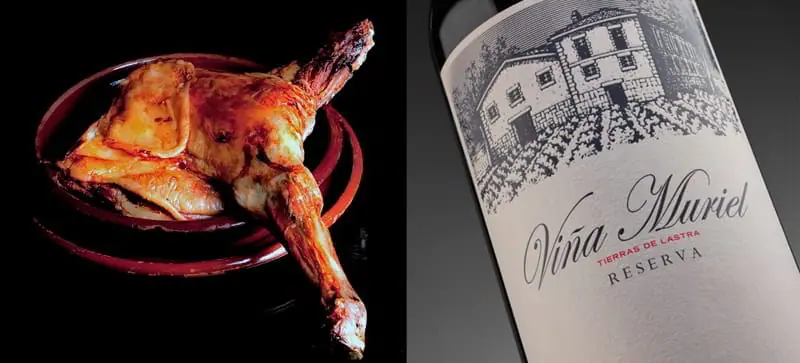Lamb is raised almost everywhere, from north to south and from east to west, but there are six geographical zones where nature and history have allied to produce indigenous races of singular properties and unique qualities. Our six IGPs are, in strict alphabetical order, the following: Codero (lamb) de Extremadura, Cordero de Navarra, Cordero Manchego, Cordero Segureño, Lechazo de Castilla y León and Ternasco de Aragón. On the Canal Cordero website it's possible to access the complete information on these indications. Here we stop at three of them to offer a characteristic recipe and a pairing with a Muriel Wines wine.
Cordero Segureño
People's taste
IGP Cordero Segureño is the southernmost of the six indications. It is located in the interior of the southeast of the Iberian Peninsula, in the heart of the eastern Betic range. It is a mountain area, where lambs of Segureño breed are born and raised among steep 'sierras'. The animal weighs between 9 and 13 Kg, and gives a fibrous, pinky flesh, with a very clean flavor.
 THE RECIPE. Lamb chops in "ajo-cabañil" style
THE RECIPE. Lamb chops in "ajo-cabañil" style
It is a very typical preparation in the provinces of Almería, Murcia, Jaén and Albacete. The first step is to crush in a mortar cumin, garlic, a pinch of pepper and a few grains of salt. Once well mashed, add vinegar and water, mix well and reserve.
Then fry both sides of the lamb chops in olive oil. When the meat is fried, lower the fire and water it with the contents of the mortar. Move the pan so that the ingredients mix well. The dish is usually served with some French fries which have been cooked in the same type of "cabañil" mixture.
For this nutritious and tasty recipe we choose a Muriel Fincas de la Villa Crianza (DOC Rioja). The Tempranillo variety, of great freshness, balances with the complexity that oak barrel aging brings, to offer a delicious contrast with the intense aromas of the chops sauce.
Lechazo de Castilla y León
The purest sobriety
35 days: not one more, although maybe less, have the lambs that bear the seal of this famous IGP. The word "lechazo" itself is already telling us what has been the exclusive food of the Castilian lambs: their mothers' milk ?"leche" in Spanish). Coming from any of the Castilian-Leonese provinces, the suckling lambs weigh between 9 and 13 Kg live and must be of one of these breeds: churra, castellana or ojalada.
 THE RECIPE. Roast Lechazo
THE RECIPE. Roast Lechazo
It is perhaps the most famous preparation, the most rooted one and the one that best expresses the essence of quality, flavor and texture of the lamb.
It is made in a roasting oven. The meat is disposed, usually by fourths, in typical clay dishes, only with salt and water. In some cases, it is very lightly "painted" with lard. Each of the lamb's fourths is baked for about an hour. During that time, the lamb gets wet with the juice of cooking. The skin should be well toasted. It is served with a simple lettuce and onion salad.
Viña Muriel Reserva (DOC Rioja), with its finesse and the nerve of its original acidity, is very suitable to accompany a very juicy tender meat, which has a very faint contribution of fat.
Ternasco de Aragón
High cuisine of lamb
Of all the IGPs dedicated to lamb, the Aragonese is ?perhaps also with Navarra? the most advanced in communication and promotion. You only have to see its attractive website, where you can find delicious recipes, events and a useful guide of restaurants.
From three breeds of sheep (rasa aragonesa, ojinegra de Teruel and roya bilbilitana), ternasco is between 70 and 90 days and has been fed with milk from the mother "ad libitum", which means "at pleasure", "at will ", for at least 50 days. Its flesh is very juicy and soft.
 THE RECIPE. Ternasco Steak tartar with mustard ice-cream
THE RECIPE. Ternasco Steak tartar with mustard ice-cream
Taken from the above mentioned website, this sophisticated though simple recipe plays with the soft and intense character of ternasco. It is not difficult, but it is full of ingredients, steps and details to keep in mind.
First we assemble the egg yolk with olive oil in a very cold bowl, until it reaches a texture similar to a mayonnaise. Once assembled, we add chopped onions, chopped pickle, a little of mustard Antique style, capers, Kimchi sauce, Worcester sauce, a little black pepper and a pinch of salt. Mix everything very well and then add the meat (previously cut with a knife into very small pieces) so that it macerates and absorbs the flavor of all the ingredients. Next, add a few drops of lime and a little bit of chopped chives.
After adding all the mentioned ingredients, we will continue to mix well for at least a couple of minutes and then let it marinate for 5 more minutes.
At the time of plating, we use a mold to shape the steak tartar and add the remaining ingredients: Kimchi mayonnaise, Sriracha, Tandoori masala, mustard ice cream and some herbs such as watercress, basil flowers or chives. The dish is accompanied by thin slices of toasted bread.
The intensity, the exotic contrasts, the superposition of textures and, dominating the whole, the distinctive flavor of ternasco meat. All this calls for a complex, deep and at the same time fresh wine. We think that Conde de los Andes blanco will shine with this great steak tartar that, by the way, is a proposal of +Albarracín restaurant in Zaragoza."
You may also be interested in:




